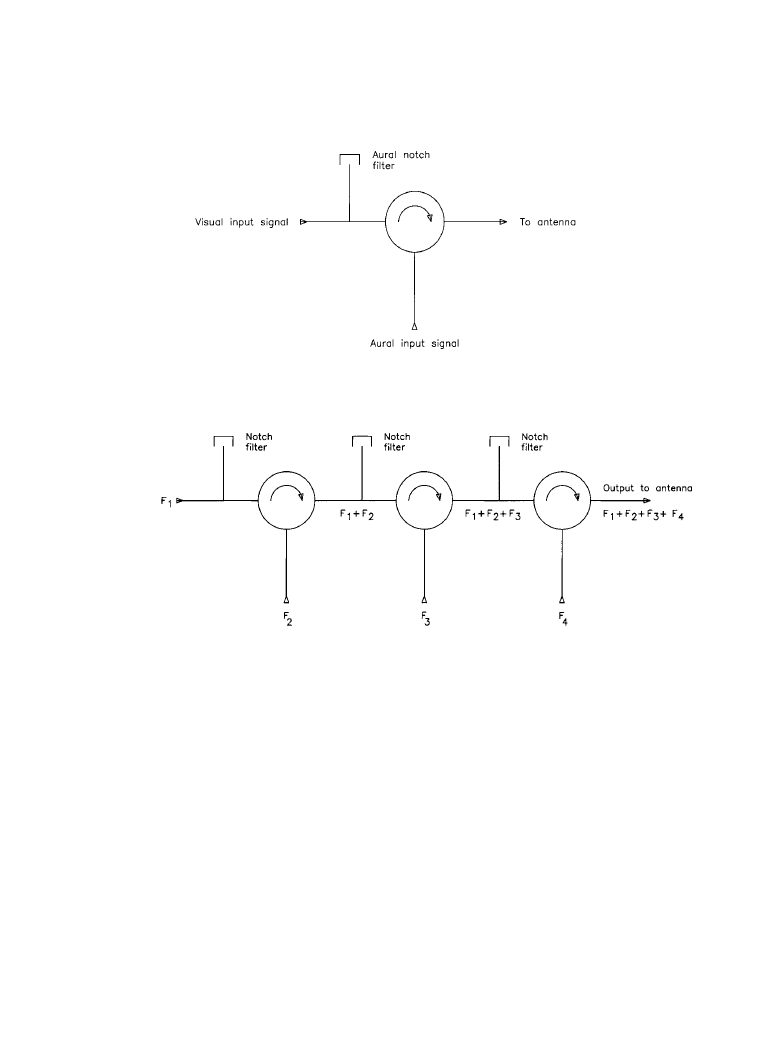ВУЗ: Казахская Национальная Академия Искусств им. Т. Жургенова
Категория: Книга
Дисциплина: Не указана
Добавлен: 03.02.2019
Просмотров: 21633
Скачиваний: 19

11-142 Broadcast Transmission Systems
Multiplexer
A multiplexer can be formed by cascading multiple circulators, as illustrated in Figure 11.6.16.
Filters must be added, as shown. The primary drawback of this approach is the increased power
dissipation that occurs in circulators nearest the antenna.
11.6.5 References
1.
Harrison, Cecil: “Passive Filters,” in The Electronics Handbook, Jerry C. Whitaker (ed.),
CRC Press, Boca Raton, Fla., pp. 279–290, 1996.
Figure 11.6.15
Use of a circulator as a diplexer in TV applications.
Figure 11.6.16
Use of a bank of circulators in a multiplexer application.
Downloaded from Digital Engineering Library @ McGraw-Hill (www.digitalengineeringlibrary.com)
Copyright © 2004 The McGraw-Hill Companies. All rights reserved.
Any use is subject to the Terms of Use as given at the website.
RF Combiner and Diplexer Systems

RF Combiner and Diplexer Systems 11-143
2.
Surette, Robert A.: “Combiners and Combining Networks,” in The Electronics Handbook,
Jerry C. Whitaker (ed.), CRC Press, Boca Raton, Fla., pp. 1368–1381, 1996.
11.6.6 Bibliography
DeComier, Bill: “Inside FM Multiplexer Systems,” Broadcast Engineering, Intertec Publishing,
Overland Park, Kan., May 1988.
Heymans, Dennis: “Hot Switches and Combiners,” Broadcast Engineering, Overland Park,
Kan., December 1987.
Stenberg, James T.: “Using Super Power Isolators in the Broadcast Plant,” Proceedings of the
Broadcast Engineering Conference, Society of Broadcast Engineers, Indianapolis, IN,
1988.
Vaughan, T., and E. Pivit: “High Power Isolator for UHF Television,” Proceedings of the NAB
Engineering Conference, National Association of Broadcasters, Washington, D.C., 1989.
Downloaded from Digital Engineering Library @ McGraw-Hill (www.digitalengineeringlibrary.com)
Copyright © 2004 The McGraw-Hill Companies. All rights reserved.
Any use is subject to the Terms of Use as given at the website.
RF Combiner and Diplexer Systems

Downloaded from Digital Engineering Library @ McGraw-Hill (www.digitalengineeringlibrary.com)
Copyright © 2004 The McGraw-Hill Companies. All rights reserved.
Any use is subject to the Terms of Use as given at the website.
RF Combiner and Diplexer Systems

12-1
Section
12
Radio Receivers
The development of radio transmission and reception must be considered one of the major tech-
nical achievements of the twentieth century. The impact of voice broadcasts to the public.
whether by commercial stations or government-run organizations, has expanded the horizons of
everyday citizens in virtually every country on earth. It is hard to overestimate the power of radio
broadcasting.
Technology has dramatically reshaped the transmission side of AM and FM broadcasting.
Profound changes have also occurred in receiver technology. Up until 1960, radio broadcasting
was basically a stationary medium. The receivers of that time were physically large and heavy,
and required 120 V ac power to drive them. The so-called portable radios of the day relied on
bulky batteries that offered only a limited amount of listening time. Automobile radios incorpo-
rated vibrator-choppers to simulate ac current. All the receivers available for commercial use
during the 1940s and 1950s used vacuum tubes exclusively.
The first technical breakthrough for radio broadcasting was the transistor, available commer-
cially at reasonable prices during the early 1960s. The transistor brought with it greatly reduced
physical size and weight, and even more importantly, it eliminated the necessity of ac line current
to power the radio. The first truly portable AM radios began to appear during the early 1960s,
with AM-FM versions following by the middle of the decade.
Many of the early receiver designs were marginal from a performance stand-point. The really
good receivers were still built around vacuum tubes. As designers learned more about transistors,
and as better transistors became available, tube-based receivers began to disappear. By 1970,
transistorized radios, as they were called, commanded the consumer market.
The integrated circuit (IC) was the second technical breakthrough in consumer receiver
design. This advance, more than anything else, made high-quality portable radios possible. It
also accelerated the change in listening habits from AM to FM. IC-based receivers allowed
designers to put more sophisticated circuitry into a smaller package, permitting consumers to
enjoy the benefits of FM broadcasting without the penalties of the more complicated receiver
required for FM stereo.
The move to smaller, lighter, more power-efficient radios has led to fundamental changes in
the way radios are built and serviced. In the days of vacuum-tube and transistor-based receivers,
the designer would build a radio out of individual stages that interconnected to provide a working
unit. The stages for a typical radio included:
Source: Standard Handbook of Audio and Radio Engineering
Downloaded from Digital Engineering Library @ McGraw-Hill (www.digitalengineeringlibrary.com)
Copyright © 2004 The McGraw-Hill Companies. All rights reserved.
Any use is subject to the Terms of Use as given at the website.

12-2 Section Twelve
•
RF amplifier
•
Local oscillator
•
Intermediate frequency (IF) amplifier
•
Detector and audio preamplifier
Today, however, large-scale integration (LSI) or even very large scale integration (VLSI)
techniques have permitted virtually all the active circuits of an AM-FM radio to be placed on a
single IC. Advanced circuitry has also permitted radio designers to incorporate all-electronic
tuning, eliminating troublesome and sometimes expensive mechanical components. Electroni-
cally tuned radios (ETRs) have made features such as “station scan” and “station seek” possible.
Some attempts were made to incorporate scan and seek features in mechanically tuned radios.
but the results were never very successful.
The result of LSI-based receiver design has been twofold. First, radios based on advanced
chip technology are much easier to build and are, therefore, usually less expensive to consumers.
Second, such radios are not serviceable. Most consumers today would not bother to have a bro-
ken radio repaired. They would simply buy a new one and throw the old one away.
Still, however, it is important to know what makes a radio work. Although radios being built
with LSI and VLSI technology do not lend themselves to stage-by-stage troubleshooting as ear-
lier radios did, it is important to know how each part of the system functions to make a working
unit. Regardless of the sophistication of a VLSI-based receiver, the basic principles of operation
are the same as a radio built of discrete stages.
In This Section:
Chapter 12.1: Receiver Characteristics
12-7
Introduction
12-7
Practical Receivers
12-8
The Receiving System
12-9
Gain, Sensitivity, and Noise Figure
12-10
NF
12-10
Minimum Detectable Signal
12-12
Selectivity
12-13
Dynamic Range
12-14
Desensitization
12-16
AM Cross Modulation
12-16
IM
12-17
Error Vector Magnitude
12-21
Gain Control
12-21
Digital Receiver Characteristics
12-25
BER Testing
12-25
Transmission and Reception Quality
12-26
Bibliography
12-27
Chapter 12.2: The Radio Channel
12-29
Introduction
12-29
Channel Impulse Response
12-30
Downloaded from Digital Engineering Library @ McGraw-Hill (www.digitalengineeringlibrary.com)
Copyright © 2004 The McGraw-Hill Companies. All rights reserved.
Any use is subject to the Terms of Use as given at the website.
Radio Receivers